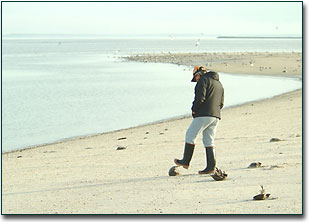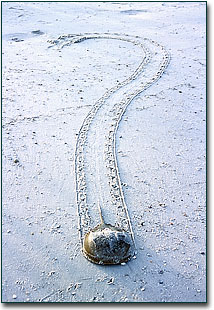This month's column, while a bit tongue in cheek - or is it cheeky - is my contribution to recent discussions on the Forum pages of NPN on the status of nature photography. Because my timing to capture hordes of shorebirds at Cape May last spring was by necessity a tad early, I surprised myself by finding something different to photograph. The images here also represent an expansion of personal horizons in that the fisherman was captured digitally with a Fuji S1 pro camera borrowed from the New England regional Fujifilm Professional rep. I'll be writing about digital acquisition in the future. For now, think about how breaking out of your own myths can broaden your shooting in the new year.
The Mooseman
A student at a nature photography workshop once said that he avoided people in his photographs because he wanted to show nature the way it should be. That statement reflects one of the three great myths about nature: "humans aren't part of the natural world". What are the other two?
- Only biologists know what's best for the survival of a species
- All people from New Jersey are a bunch of yahoos
What's a yahoo? You have to come from a really rural place to fully appreciate the designation. As applied by the good old boys of my home state, the term describes folks who, once they step into the Maine woods start running around yelling: "Yahoo! We're in the wild!"
Some who are lucky enough to live in Maine consider anyone from South of the Border - the one with New Hampshire - as either a "flatlander" or a yahoo. I usually reserve such species identification until folks prove themselves to be of that ilk. I've also met some yahoos with Maine plates. But they must have been transplants? In any event, I know that none who visit this site would qualify, no matter their place of origin.
On a spring 2001 trip to New Jersey, I had the opportunity to dispel all three of these myths with a single image. There's a lesson in the story of this photograph for each of us. To understand its significance, we first need to explore one of the nature's most fascinating occurrences.
Natural Spectacle
Each May and June, a spectacle of nature occurs on the shores of Delaware Bay. One part of that spectacle is the several week stopover for refueling during their northward migration by as many as a millions shorebirds. These birds then head to breeding grounds as far away as the Arctic. In recent years, researchers have discovered that the Delaware Bay region provides the largest staging area for shorebirds on the Atlantic Flyway, and the second largest staging area in North America.
Hundreds of thousands of these birds fly to the Cape May, New Jersey region from the south coast of Brazil - a mere 7,000 miles as the ruddy turnstone flies. When they arrive, they need lots of food to replenish fat reserves for the rest of their journey. Besides ruddy turnstones, there are sanderlings, sandpipers and red knots dominate this massive stopover. Less numerous species, such as piping plovers, also participate.
 The shorebird stopover is just part of this spring spectacle. The other part is the annual spawning by one of the most ancient species on the planet, the horseshoe crab. Not really a crab at all, but a non-biting relative of the scorpion and the tick, the horseshoe crab has existed for over two hundred million years. The Delaware Bay region is home to the largest population of the American horseshoe crab Limulus polyphemus, which lives along the shores of the Atlantic Ocean from Maine to Mexico.
The shorebird stopover is just part of this spring spectacle. The other part is the annual spawning by one of the most ancient species on the planet, the horseshoe crab. Not really a crab at all, but a non-biting relative of the scorpion and the tick, the horseshoe crab has existed for over two hundred million years. The Delaware Bay region is home to the largest population of the American horseshoe crab Limulus polyphemus, which lives along the shores of the Atlantic Ocean from Maine to Mexico.
Each spring during the higher tides of the new and full moons, thousands of horseshoe crabs crawl onto Delaware Bay shorelines to lay their eggs. The females burrow into the sand between the tide lines to deposit some 3,000 eggs per nest. The males then fertilize the eggs. Biologists estimate that as many as 4 million horseshoe crabs have covered these beaches during some springs.
This ritual and the shorebird stopover coincide, and not by accident. As huge numbers of horseshoe crabs attempt to fill several nests each on each trip to the beach, they often dig up other nests and lay bare their eggs. The shorebirds seek out this bonanza.
This relationship was only brought to light by biologists in the 1970's. While it presumably has occurred for eons, from the 1880's to the 1920's horseshoe crabs were heavily harvested for fertilizer. With a species that takes 9 years to reach sexual maturity, harvesting of a million crabs a year led to their depletion such that, from the 1930's to 1960's, no significant shorebird staging was reported by birders. After the invention of modern fertilizers, it took fifty years for the horseshoe crab population to rebound. And that's when the biologists noted the coinciding spring stopover by all of those shorebirds.
Humans have found a new use for horseshoe crabs in recent years. Commercial fishermen have discovered that they make good bait for eels and whelk. Dragging for tens of thousands of horseshoe crabs at a time has led to concerns that this ancient resource is once again in danger.
 The Fisherman
The Fisherman
The fisherman in the photograph and I met on a Cape May beach one morning this past May. After he set his pole for stripers, we talked about the birds and the horseshoe crabs. A life-long native of New Jersey who'd fished here some 40 years, he recalled springs when you could hardly walk on these beaches for all the horseshoe crabs laying eggs. He lamented their present decline, and said he guessed it was because of over harvesting for fertilizer and bait for commercial fishing.
When we talked about where I hailed from, he said he'd fished in New England. He said he appreciated the way biologists up there protected some of the piping plover nest sites with small fenced areas. Down here, he said, they close off the whole beach, and you can't even walk down it to fish. While I wondered if it was due to the large numbers of folks that wanted to do that as compared to our northern shores, I kept silent.
He also didn't know that I'd photographed him earlier as he'd flipped over a number of horseshoe crabs stranded on their backs by the receding tide. I asked him why he did that.
"I don't know if they're kamikazes or what," he replied. "But I figure, what with all the birds needing their eggs, every crab helps."
Even the ones that feed piping plovers, I mused to myself. My new friend was no biologist. But he was certainly no yahoo either. He's captured here, doing his thing for nature - one crab at a time.
The other photograph here, shot on film, also says it all for me. This crab seemed to be speaking for the status of its species when it wrote cryptically on that Cape May beach. Perhaps with the help of folks like my fisherman friend, that status will be less questionable in the future.
Catch yours in the good light.
BS-NPN 012
http://camerahunter.com
Comments on Bill Silliker, Jr.'s The Camera Hunter articles? Send them to the editor.
Maine wildlife & nature photographer Bill Silliker, Jr. – The Mooseman - photographed at many wild places in North America, with the results published in magazines internationally and in 9 of his own books. Bill was an instructor of wildlife and nature photography for L. L. Bean's Outdoor Discovery Program and a member of the Fuji Film Talent Team. Read more about Bill on the Camera Hunter archives page.



